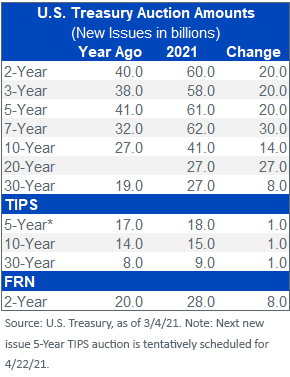By Kevin Flanagan, Head of Fixed Income Strategy
Without a doubt, the biggest story in bond-land, if not the financial markets in general, thus far in 2021 has been the spike in the U.S. Treasury 10-year yield. This increase has been fueled by a variety of factors, but there is one aspect that has not received the lion’s share of attention, and after I did a little research, it really caught my eye; the size of Treasury auctions.
When budget deficits are running in the multi-trillions, guess what? You have to finance this huge gap. That is exactly what is happening for the Treasury debt managers. At this point, the federal government’s financing needs reflect the baseline trillion-dollar deficit coming into this fiscal year as well as any holdovers from the prior pandemic-related fiscal stimulus packages that were enacted. Thus, the $900 billion package from December is part of the mix, but the $1.9 trillion dollar proposal currently being debated in the Senate would be another enormous add-on.
The enclosed table highlights the auction amounts currently in place versus the totals that were being auctioned for each security/maturity a year ago. Certainly, the 20-Year bond stands out as this issue was not being offered at this time in 2020. For the record, this maturity was brought back in May of last year to help with the debt load for the first time since 1986.
The other issue to stand out is the 7-Year note, where the present auction amount is an incredible $30 billion more than a year ago. The abysmal reception at the most recent auction for this maturity not only made headlines, but also got me thinking that maybe there are limits as to how much paper can be digested without investors commanding higher yields in return. The remaining note structure (2-, 3-, 5-Year) is $20 billion higher for each maturity, with the aforementioned 10-Year note being $14 billion above its 2020 reading.
Interestingly, the TIPS line-up is ‘only’ up $1 billion each, while the FRN offering got an $8 billion boost. It seems apparent the debt managers felt the FRN structure would be a preferred vehicle to raise cash rather than TIPS.
Conclusion
So, that raises the question: what is too big? Up until the very disappointing 7-Year note auction last month, it appeared as if auction sizes did not have any near-term limitations. However, maybe, just maybe, budget deficits do matter after all because someone has to finance them, and to quote: “There’s no such thing as a free lunch.”
Originally published by WisdomTree, 3/10/21
U.S. investors only: Click here to obtain a WisdomTree ETF prospectus which contains investment objectives, risks, charges, expenses, and other information; read and consider carefully before investing.
There are risks involved with investing, including possible loss of principal. Foreign investing involves currency, political and economic risk. Funds focusing on a single country, sector and/or funds that emphasize investments in smaller companies may experience greater price volatility. Investments in emerging markets, currency, fixed income and alternative investments include additional risks. Please see prospectus for discussion of risks.
Past performance is not indicative of future results. This material contains the opinions of the author, which are subject to change, and should not to be considered or interpreted as a recommendation to participate in any particular trading strategy, or deemed to be an offer or sale of any investment product and it should not be relied on as such. There is no guarantee that any strategies discussed will work under all market conditions. This material represents an assessment of the market environment at a specific time and is not intended to be a forecast of future events or a guarantee of future results. This material should not be relied upon as research or investment advice regarding any security in particular. The user of this information assumes the entire risk of any use made of the information provided herein. Neither WisdomTree nor its affiliates, nor Foreside Fund Services, LLC, or its affiliates provide tax or legal advice. Investors seeking tax or legal advice should consult their tax or legal advisor. Unless expressly stated otherwise the opinions, interpretations or findings expressed herein do not necessarily represent the views of WisdomTree or any of its affiliates.
The MSCI information may only be used for your internal use, may not be reproduced or re-disseminated in any form and may not be used as a basis for or component of any financial instruments or products or indexes. None of the MSCI information is intended to constitute investment advice or a recommendation to make (or refrain from making) any kind of investment decision and may not be relied on as such. Historical data and analysis should not be taken as an indication or guarantee of any future performance analysis, forecast or prediction. The MSCI information is provided on an “as is” basis and the user of this information assumes the entire risk of any use made of this information. MSCI, each of its affiliates and each entity involved in compiling, computing or creating any MSCI information (collectively, the “MSCI Parties”) expressly disclaims all warranties. With respect to this information, in no event shall any MSCI Party have any liability for any direct, indirect, special, incidental, punitive, consequential (including loss profits) or any other damages (www.msci.com)
Jonathan Steinberg, Jeremy Schwartz, Rick Harper, Christopher Gannatti, Bradley Krom, Tripp Zimmerman, Michael Barrer, Anita Rausch, Kevin Flanagan, Brendan Loftus, Joseph Tenaglia, Jeff Weniger, Matt Wagner, Alejandro Saltiel, Ryan Krystopowicz, Kara Marciscano, Jianing Wu and Brian Manby are registered representatives of Foreside Fund Services, LLC.
WisdomTree Funds are distributed by Foreside Fund Services, LLC, in the U.S. only.
You cannot invest directly in an index.









